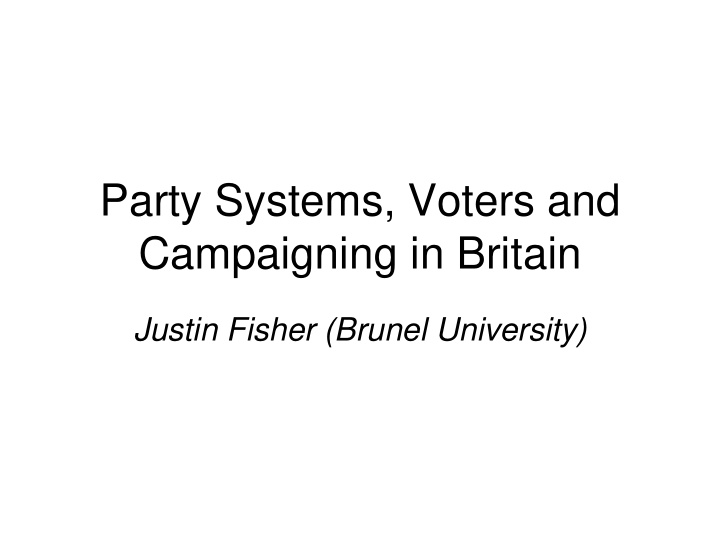



Party Systems, Voters and Campaigning in Britain Justin Fisher (Brunel University)
PARTY SYSTEMS IN THE UK
Calculation of ENEP 1 p i 2
ENEP 2010 1 (.36 + .29 + .23 + .12) 2 = 3.55
BACK TO TWO DOMINANT PARTIES?
IMPACT OF DEVOLUTION
THE IMPACT OF ELECTORAL SYSTEMS
To What Extent Does the Electoral System Shape the Behaviour of Voters? • It is no use assuming that voters will behave in the same way regardless of the electoral system, especially if some systems require ranked preferences to be made. • Hypothesis: Voters’ behaviour will change under different electoral systems, since voter choice is constrained or liberated by the electoral system in place.
Assumptions • Voter choice is constrained by systems like first past the post since voters consider that the national outcome is likely to be one of two parties governing and that in constituencies, there are generally only two likely victors. • Whatever voting system is used, voters would not split their vote since the effects of ideological commitment and partisan identification are too strong
How do we test these assumptions? • Survey evidence using mock-ballots • Aggregate evidence from two elections held on the same day • Aggregate evidence from AMS elections in Britain
Evidence from 2010 – Vote Same as First Choice in Mock AV Ballot? Conservative 91% Labour 90% Lib Dems 75% Source: BES 2010 England Only
Concurrent Elections • When local and general elections coincide, it is possible to compare at the aggregate level, voting in two elections where voters would have voted at exactly the same time. • There is some evidence of ticket- splitting - thus undermining arguments about strong identification.
Example - Local/General Election Vote Comparisons 1997 % Con Lab Lib Dem Ref Other Turnout Local 33.0 38.5 23.1 0.0 3.6 70.8 General 34.8 42.3 16.8 3.2 1.5 71.7 Difference 1.8 3.7 -6.3 3.2 -2.2 0.9 Source: Rallings & Thrasher, 1998
AMS Elections • Voters cast two votes – one at constituency level, one for the regional list • If voters use both votes, they can either vote for the same party twice, split their ticket (esp. if a smaller party is only standing in the regional list) or use only one vote. • The example of the Scottish Parliament election in 2007 suggests that some ticket splitting took place – smaller parties are the beneficiaries.
Example - Scottish Parliament Elections 2007 % Vote Constit. List Diff. Share Labour 32.1 29.2 2.9 SNP 32.9 31.0 1.9 Lib Dems 16.2 11.3 4.9 Cons 16.6 13.9 2.7 Others 2.2 14.6 12.4 Source: House of Commons Library
Overall • The evidence to date does suggest that voters do sometimes behave differently under different systems and at different levels of government. • But is the difference in behaviour as strong as we might expect?
DECLINING LOYALTIES TO PARTIES
Source: British Election Study
Two Measures of Volatility • Net Volatility. Aggregate data – Pederson Index • Gross Volatility. Individual level data • Both suggest an increase in voter volatility • Do levels of volatility reflect declining loyalty?
Source: British Election Study
THE IMPACT OF CAMPAIGNS AT DISTRICT LEVEL
Conducive Conditions • Conditions more conducive to campaign effectiveness • Partisan identification has declined in intensity • Voter hesitancy has increased • More waverers to convert or reinforce
Measuring Campaign Strength • Surveys of election agents in each constituency which ask them to provide details of their party’s level of preparation, organization, the number of party workers, the amounts and different types of campaigning that took place and the extent of activity on polling day. • A scale of campaign intensity is constructed which allows us to test the distribution of activity by seat status as well as the electoral effects
Mean Campaign Intensity Scores 1992-2010 Conservative Labour Lib Dems 1992 1997 2001 2005 2010 1992 1997 2001 2005 2010 1992 1997 2001 2005 2010 Held 139 126 127 133 118 114 110 106 111 117 * * 112 126 * Not Targets Targets 134 133 134 136 139 143 152 137 135 134 123 140 132 141 143 Not 94 94 87 117 91 93 105 86 77 76 49 76 71 77 82 Held Not Targets All 124 112 113 133 112 112 113 105 102 100 82 81 78 90 90 Scores can be compared across parties for the same year, but not over time
Electoral Effects • Campaigning overall boosts turnout • Liberal Democrat campaigning has consistently boosted vote share • Labour campaigning boosted vote share except in 2005 • Conservative campaigning generally ineffective except in 2010 • Impact of campaigning varies by election
Exogenous factors influencing likely effectiveness of constituency campaigns More Effective Less Effective Closeness of Popularity Unpopular party(ies) Election Equilibrium Significant Change Challenger(s) Incumbent Likely High No’s of Target Unpopular party(ies) Popularity Seats Equilibrium Central Clear Objectives Unclear Objectives Management
Concluding Thoughts • Was 2010 the highpoint for multi-partism at Westminster Level? • Electoral systems have some impact on voter choices, but maybe not as much as expected • Declining loyalties to parties means short- term influences may be more influential • For example, campaigning at constituency level generally yields payoffs
Recommend
More recommend